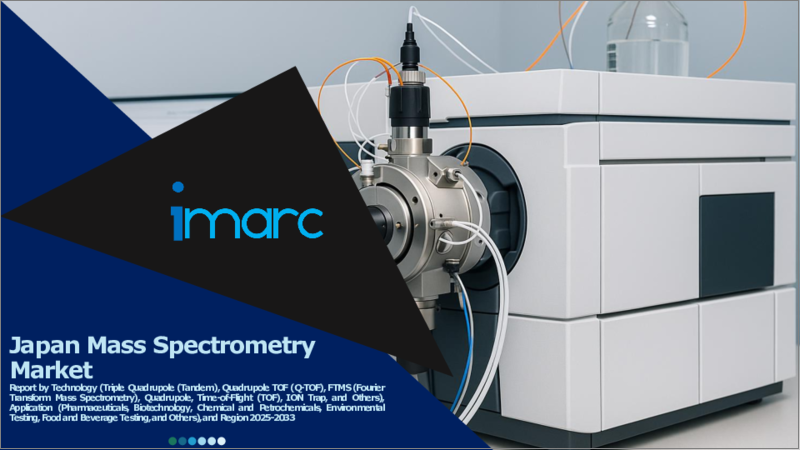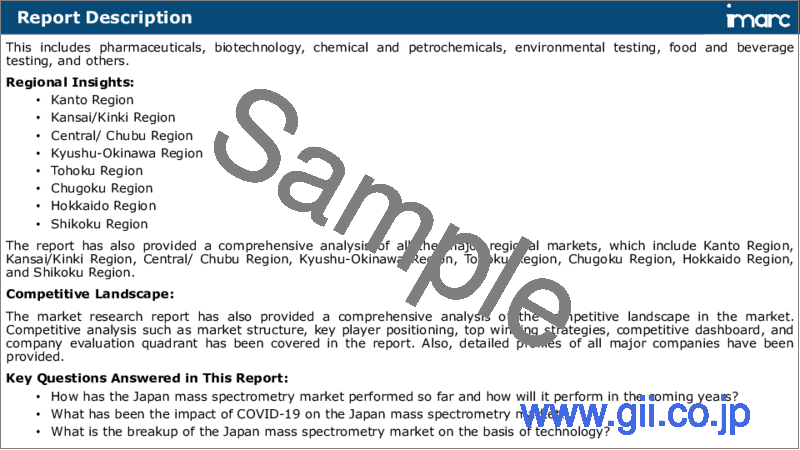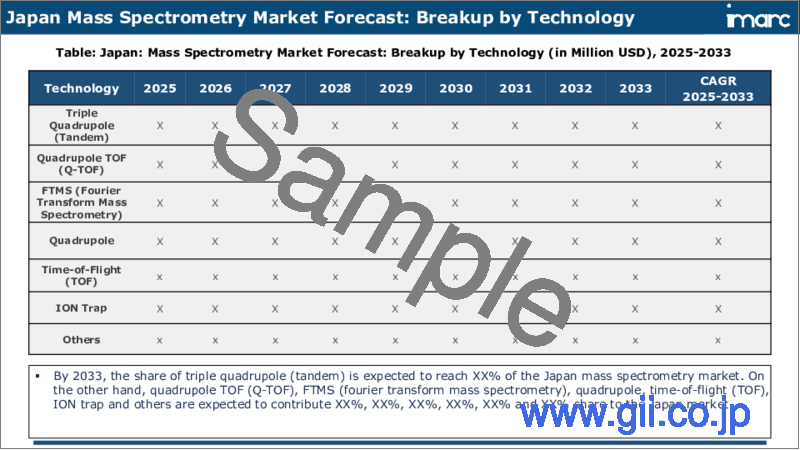|
|
市場調査レポート
商品コード
1729332
日本の質量分析市場レポート:技術、用途、地域別、2025年~2033年Japan Mass Spectrometry Market Report by Technology (Triple Quadrupole, Quadrupole TOF, FTMS, Quadrupole, Time-of-Flight, ION Trap, and Others), Application, and Region 2025-2033 |
||||||
カスタマイズ可能
|
|||||||
| 日本の質量分析市場レポート:技術、用途、地域別、2025年~2033年 |
|
出版日: 2025年05月01日
発行: IMARC
ページ情報: 英文 121 Pages
納期: 5~7営業日
|
全表示
- 概要
- 目次
日本の質量分析の市場規模は2024年に4億800万米ドルに達しました。今後、IMARC Groupは、市場は2033年までに6億6,200万米ドルに達し、2025~2033年の成長率(CAGR)は5.5%になると予測しています。医薬品開発、品質管理、規制遵守のために質量分析に大きく依存している新興国市場とバイオテクノロジー分野が、主に市場を牽引しています。
本レポートで扱う主な質問
- 日本の質量分析市場はこれまでどのように推移し、今後数年間はどのように推移するのか?
- COVID-19が日本の質量分析市場に与えた影響は?
- 日本の質量分析市場の技術別区分は?
- 日本の質量分析市場の用途別区分は?
- 日本の質量分析市場のバリューチェーンにおける様々なステージとは?
- 日本の質量分析の主な促進要因と課題は何か?
- 日本の質量分析市場の構造と主要プレーヤーは?
- 日本の質量分析市場における競合の程度は?
目次
第1章 序文
第2章 調査範囲と調査手法
- 調査の目的
- ステークホルダー
- データソース
- 市場推定
- 調査手法
第3章 エグゼクティブサマリー
第4章 日本の質量分析市場:イントロダクション
- 概要
- 市場力学
- 業界動向
- 競合情報
第5章 日本の質量分析市場情勢
- 過去および現在の市場動向(2019~2024年)
- 市場予測(2025~2033年)
第6章 日本の質量分析市場:技術別の内訳
- トリプル四重極(タンデム)
- 四重極TOF(Q-TOF)
- FTMS(フーリエ変換質量分析法)
- 四重極
- 飛行時間型(TOF)
- イオントラップ
- その他
第7章 日本の質量分析市場:用途別の内訳
- 医薬品
- バイオテクノロジー
- 化学および石油化学
- 環境試験
- 食品および飲料の検査
- その他
第8章 日本の質量分析市場:競合情勢
- 概要
- 市場構造
- 市場企業のポジショニング
- 主要成功戦略
- 競合ダッシュボード
- 企業評価象限
第9章 主要企業のプロファイル
第10章 日本の質量分析市場:業界分析
- 促進要因、抑制要因、機会
- ポーターのファイブフォース分析
- バリューチェーン分析
第11章 付録
Japan mass spectrometry market size reached USD 408 Million in 2024. Looking forward, IMARC Group expects the market to reach USD 662 Million by 2033, exhibiting a growth rate (CAGR) of 5.5% during 2025-2033. The expanding pharmaceutical and biotechnology sectors, which rely heavily on mass spectrometry for drug development, quality control, and regulatory compliance, is primarily driving the market.
Mass spectrometry refers to a powerful analytical technique used in chemistry and biology to identify and quantify molecules based on their mass-to-charge ratio. It works by first ionizing a sample, turning its molecules into charged particles, and then separating these ions according to their mass in a mass spectrometer. The process involves three main steps: ionization, mass analysis, and detection. In ionization, the sample is bombarded with high-energy electrons or subjected to other ionization methods, causing it to lose or gain electrons and become ions. These ions are then accelerated into a mass analyzer, where they are sorted based on their mass-to-charge ratio, creating a spectrum of ion intensities. Finally, the ions are detected, and the resulting data is used to determine the composition, structure, and quantity of the molecules in the sample. Mass spectrometry finds applications in various fields, including chemistry, biochemistry, environmental science, and forensics, enabling researchers to analyze complex mixtures, identify unknown compounds, and study molecular structures with high precision and sensitivity.
Japan Mass Spectrometry Market Trends:
The mass spectrometry market in Japan is experiencing robust growth due to several key drivers. Firstly, advancements in analytical techniques have fueled the demand for mass spectrometry instruments. Moreover, the increasing prevalence of complex diseases like cancer and the need for precise diagnostics have led to greater adoption of mass spectrometry in clinical research and healthcare, serving as a catalyst for market expansion. Additionally, the expanding pharmaceutical and biotechnology sectors have heightened the demand for mass spectrometers in drug discovery and development, further propelling market growth. Apart from this, the burgeoning interest in proteomics and metabolomics research to decipher intricate biological processes has amplified the utilization of mass spectrometry. The ability to provide accurate and high-throughput analysis of biomolecules has made mass spectrometry an indispensable tool in life sciences research. Moreover, stringent regulations and quality control standards in various industries, such as food and environmental monitoring, have driven the need for precise analytical techniques, leading to increased adoption of mass spectrometry systems. In conclusion, a convergence of factors, including technological advancements, healthcare demands, scientific research needs, and regulatory requirements, is expected to drive the mass spectrometry market in Japan.
Japan Mass Spectrometry Market Segmentation:
Technology Insights:
- Triple Quadrupole (Tandem)
- Quadrupole TOF (Q-TOF)
- FTMS (Fourier Transform Mass Spectrometry)
- Quadrupole
- Time-of-Flight (TOF)
- ION Trap
- Others
Application Insights:
- Pharmaceuticals
- Biotechnology
- Chemical and Petrochemicals
- Environmental Testing
- Food and Beverage Testing
- Others
Competitive Landscape:
The market research report has also provided a comprehensive analysis of the competitive landscape in the market. Competitive analysis such as market structure, key player positioning, top winning strategies, competitive dashboard, and company evaluation quadrant has been covered in the report. Also, detailed profiles of all major companies have been provided.
Key Questions Answered in This Report:
- How has the Japan mass spectrometry market performed so far and how will it perform in the coming years?
- What has been the impact of COVID-19 on the Japan mass spectrometry market?
- What is the breakup of the Japan mass spectrometry market on the basis of technology?
- What is the breakup of the Japan mass spectrometry market on the basis of application?
- What are the various stages in the value chain of the Japan mass spectrometry market?
- What are the key driving factors and challenges in the Japan mass spectrometry?
- What is the structure of the Japan mass spectrometry market and who are the key players?
- What is the degree of competition in the Japan mass spectrometry market?
Table of Contents
1 Preface
2 Scope and Methodology
- 2.1 Objectives of the Study
- 2.2 Stakeholders
- 2.3 Data Sources
- 2.3.1 Primary Sources
- 2.3.2 Secondary Sources
- 2.4 Market Estimation
- 2.4.1 Bottom-Up Approach
- 2.4.2 Top-Down Approach
- 2.5 Forecasting Methodology
3 Executive Summary
4 Japan Mass Spectrometry Market - Introduction
- 4.1 Overview
- 4.2 Market Dynamics
- 4.3 Industry Trends
- 4.4 Competitive Intelligence
5 Japan Mass Spectrometry Market Landscape
- 5.1 Historical and Current Market Trends (2019-2024)
- 5.2 Market Forecast (2025-2033)
6 Japan Mass Spectrometry Market - Breakup by Technology
- 6.1 Triple Quadrupole (Tandem)
- 6.1.1 Overview
- 6.1.2 Historical and Current Market Trends (2019-2024)
- 6.1.3 Market Forecast (2025-2033)
- 6.2 Quadrupole TOF (Q-TOF)
- 6.2.1 Overview
- 6.2.2 Historical and Current Market Trends (2019-2024)
- 6.2.3 Market Forecast (2025-2033)
- 6.3 FTMS (Fourier Transform Mass Spectrometry)
- 6.3.1 Overview
- 6.3.2 Historical and Current Market Trends (2019-2024)
- 6.3.3 Market Forecast (2025-2033)
- 6.4 Quadrupole
- 6.4.1 Overview
- 6.4.2 Historical and Current Market Trends (2019-2024)
- 6.4.3 Market Forecast (2025-2033)
- 6.5 Time-of-Flight (TOF)
- 6.5.1 Overview
- 6.5.2 Historical and Current Market Trends (2019-2024)
- 6.5.3 Market Forecast (2025-2033)
- 6.6 ION Trap
- 6.6.1 Overview
- 6.6.2 Historical and Current Market Trends (2019-2024)
- 6.6.3 Market Forecast (2025-2033)
- 6.7 Others
- 6.7.1 Historical and Current Market Trends (2019-2024)
- 6.7.2 Market Forecast (2025-2033)
7 Japan Mass Spectrometry Market - Breakup by Application
- 7.1 Pharmaceuticals
- 7.1.1 Overview
- 7.1.2 Historical and Current Market Trends (2019-2024)
- 7.1.3 Market Forecast (2025-2033)
- 7.2 Biotechnology
- 7.2.1 Overview
- 7.2.2 Historical and Current Market Trends (2019-2024)
- 7.2.3 Market Forecast (2025-2033)
- 7.3 Chemical and Petrochemicals
- 7.3.1 Overview
- 7.3.2 Historical and Current Market Trends (2019-2024)
- 7.3.3 Market Forecast (2025-2033)
- 7.4 Environmental Testing
- 7.4.1 Overview
- 7.4.2 Historical and Current Market Trends (2019-2024)
- 7.4.3 Market Forecast (2025-2033)
- 7.5 Food and Beverage Testing
- 7.5.1 Overview
- 7.5.2 Historical and Current Market Trends (2019-2024)
- 7.5.3 Market Forecast (2025-2033)
- 7.6 Others
- 7.6.1 Historical and Current Market Trends (2019-2024)
- 7.6.2 Market Forecast (2025-2033)
8 Japan Mass Spectrometry Market - Competitive Landscape
- 8.1 Overview
- 8.2 Market Structure
- 8.3 Market Player Positioning
- 8.4 Top Winning Strategies
- 8.5 Competitive Dashboard
- 8.6 Company Evaluation Quadrant
9 Profiles of Key Players
- 9.1 Company A
- 9.1.1 Business Overview
- 9.1.2 Product Portfolio
- 9.1.3 Business Strategies
- 9.1.4 SWOT Analysis
- 9.1.5 Major News and Events
- 9.2 Company B
- 9.2.1 Business Overview
- 9.2.2 Product Portfolio
- 9.2.3 Business Strategies
- 9.2.4 SWOT Analysis
- 9.2.5 Major News and Events
- 9.3 Company C
- 9.3.1 Business Overview
- 9.3.2 Product Portfolio
- 9.3.3 Business Strategies
- 9.3.4 SWOT Analysis
- 9.3.5 Major News and Events
- 9.4 Company D
- 9.4.1 Business Overview
- 9.4.2 Product Portfolio
- 9.4.3 Business Strategies
- 9.4.4 SWOT Analysis
- 9.4.5 Major News and Events
- 9.5 Company E
- 9.5.1 Business Overview
- 9.5.2 Product Portfolio
- 9.5.3 Business Strategies
- 9.5.4 SWOT Analysis
- 9.5.5 Major News and Events
10 Japan Mass Spectrometry Market - Industry Analysis
- 10.1 Drivers, Restraints and Opportunities
- 10.1.1 Overview
- 10.1.2 Drivers
- 10.1.3 Restraints
- 10.1.4 Opportunities
- 10.2 Porters Five Forces Analysis
- 10.2.1 Overview
- 10.2.2 Bargaining Power of Buyers
- 10.2.3 Bargaining Power of Suppliers
- 10.2.4 Degree of Competition
- 10.2.5 Threat of New Entrants
- 10.2.6 Threat of Substitutes
- 10.3 Value Chain Analysis






